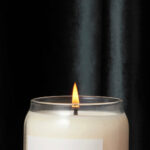As someone who loves candles, I am often mesmerized by the soft glow and soothing fragrance of a lit candle. It is important to always be mindful of the potential dangers linked to candles. A common concern people have is, ‘How long can a candle burn safely when left unattended?’
The truth is, leaving a candle unattended is never recommended. Even a seemingly innocent flame can quickly turn into a dangerous situation if left unchecked. In this article, I will share essential guidelines and precautions to ensure your candle-burning experience remains enjoyable and safe. From understanding the risks of unattended candles to exploring alternative flameless options, we will cover it all.
So, join me as we delve into the world of candle safety and discover the best practices to keep your home cozy and hazard-free.
Key Takeaways
- Leaving a candle unattended is not recommended due to potential dangers.
- Candles are responsible for thousands of residential fires each year.
- Proper candle setup includes stable and heat-resistant surfaces, keeping candles out of reach of children and pets, and using flameless alternatives.
- Extinguish candles before leaving the room or going to bed to ensure safety.
Understand the Risks of Leaving Candles Unattended
Leaving candles unattended can be incredibly risky, putting your home and loved ones in danger. It is crucial to understand the importance of never leaving a burning candle alone. The potential dangers associated with unattended candles are numerous.
First and foremost, a forgotten candle can easily ignite nearby objects, such as curtains or papers, leading to a devastating fire. In fact, according to the National Fire Protection Association, candles are responsible for thousands of residential fires each year.
Additionally, pets or children may accidentally knock over a candle, causing it to spill hot wax or even start a fire. Moreover, if a candle burns down completely without supervision, it can create a hazardous situation. The flame can come into contact with the surface it is placed on, causing it to catch fire.
To prevent these risks, it is important to keep candles away from flammable objects such as curtains, furniture, or decorations. By taking these precautions, we can ensure the safety of our homes and loved ones.
Keep Candles Away from Flammable Objects
Make sure to always keep candles well away from any flammable objects to prevent any potential fire hazards, as even the smallest spark could ignite a catastrophe. Candle safety precautions are essential to ensure a safe and enjoyable ambiance.
Placing candles near curtains, furniture, or other flammable materials increases the risk of fire. It is crucial to maintain a minimum distance of at least one foot between candles and anything that can catch fire easily.
To further enhance fire prevention measures, consider placing candles on sturdy and heat-resistant surfaces. Avoid placing them on wooden or plastic surfaces that can melt or catch fire. Instead, opt for metal, glass, or ceramic candle holders and containers. These materials provide a stable base and reduce the risk of accidental tipping or spilling.
By adhering to these candle safety precautions and implementing fire prevention measures, you can significantly reduce the risk of accidents and potential catastrophes. Use proper candle holders and containers to ensure stability and minimize the chance of fires caused by negligence.
Taking these precautions will help create a safe and enjoyable environment while enjoying the warm glow and soothing aroma of candles.
Use Proper Candle Holders and Containers
Ensure your candles are placed in appropriate holders and containers to enhance their stability and reduce the risk of accidents. Using proper candle holders and containers is essential for candle safety and preventing candle accidents. Here are four important reasons why you should always use the right holders and containers:
-
Stability: The right holder or container will keep your candle securely in place, preventing it from tipping over and causing a fire or other accidents.
-
Heat resistance: A suitable holder or container will be made of heat-resistant materials, ensuring it can withstand the heat generated by the candle without melting or catching fire.
-
Fire protection: Some holders and containers are designed with fire-resistant properties, which can help contain the flame in case of an accident and prevent it from spreading.
-
Airflow control: Certain holders and containers have features that allow for proper airflow around the candle, helping it burn evenly and reducing the risk of overheating.
By using appropriate holders and containers, you can significantly enhance candle safety and minimize the chances of accidents. It’s important to remember that even with proper containers, it’s crucial to trim the candle wick regularly to further reduce the risk of accidents.
Trim the Candle Wick Regularly
To maintain a safe burning environment, remember to regularly trim your candle wick to prevent excessive flame height and potential hazards. Wick maintenance is an essential part of candle safety precautions.
When a candle burns, the wick can become too long, causing the flame to grow too high. This can lead to the candle burning too hot, increasing the risk of a fire. By trimming the wick to a quarter of an inch before each use, you can ensure a controlled and safe flame.
Trimming the wick also helps to promote a clean and even burn. When a wick is too long, it can create a larger flame that melts the wax unevenly, resulting in tunneling and wasted wax. By keeping the wick trimmed, you allow the candle to burn evenly, maximizing its burn time and ensuring that you get the most out of your candle.
Now that you understand the importance of wick maintenance, let’s move on to the next topic: never leave candles burning overnight. It’s crucial to be mindful of your candles and never leave them unattended for extended periods, especially when you’re asleep.
Never Leave Candles Burning Overnight
Remember, it’s important to always extinguish your candles before going to bed to avoid any potential risks or hazards. Leaving candles burning overnight can be extremely dangerous and should be avoided at all costs. Not only can it lead to house fires, but it can also cause harm to you and your loved ones. To emphasize the importance of candle safety, let’s take a look at the potential dangers of leaving candles unattended.
| Potential Dangers | Emotional Response |
|---|---|
| Fire hazard | Fear |
| Toxic fumes | Alarm |
| Burns and injuries | Concern |
| Property damage | Anxiety |
Leaving candles burning overnight increases the chances of a fire breaking out, which can quickly spread and cause extensive damage. In addition, the toxic fumes released by burning candles can pose a health risk, especially if inhaled for an extended period. Accidents, such as burns and injuries, are more likely to occur if candles are left unsupervised. Moreover, property damage can result from an unattended candle that falls or comes into contact with flammable objects.
To create a safe candle setup, it’s essential to implement proper candle safety tips and avoid the potential dangers mentioned above.
Create a Safe Candle Setup
Set the stage for a secure candle experience by crafting a haven where flickering flames dance in harmony with your tranquil surroundings. When it comes to candle safety, it’s important to create a safe candle setup.
Start by placing candles on stable, heat-resistant surfaces, away from flammable materials. Always keep them out of reach of children and pets, and never leave them unattended. To minimize the risk of accidents, consider using safe candle alternatives such as LED candles or battery-operated ones. These flameless options can still create a cozy atmosphere without the hazards of an open flame.
Additionally, following a few candle safety tips can further ensure a secure ambiance. Trim the wicks to ¼ inch before each use to prevent excessive sooting and uneven burning. Use candle holders that fit the size of your candles, and avoid overcrowding them. Finally, extinguish candles before leaving the room or going to bed.
By implementing these safe candle practices, you can enjoy the warm glow of flickering lights with peace of mind. As we move on to the next section, let’s consider the benefits of flameless candle alternatives.
Consider Flameless Candle Alternatives
Creating a safe candle setup is crucial to prevent accidents and ensure the well-being of your home. However, even with all the necessary precautions, it’s still recommended to consider flameless candle alternatives.
Flameless candles have become increasingly popular due to their numerous benefits. Not only do they eliminate the risk of fire hazards, but they also provide a worry-free option for leaving a candle unattended. With flameless candles, you can enjoy the warm, flickering glow without the need for an open flame. These candles are typically battery-operated and use LED lights to mimic the appearance of a real flame. Additionally, they come in a variety of shapes, sizes, and designs, allowing you to find the perfect fit for your home decor.
By opting for flameless candle options, you can enjoy the ambiance and beauty of candles without compromising safety.
Transitioning into the next section, it’s essential to teach children and pets candle safety to further ensure a secure environment.
Teach Children and Pets Candle Safety
To keep your little ones and furry friends safe, it’s crucial to teach them about the importance of candle safety. Children and pets are naturally curious, so they need to understand the potential fire hazards associated with candles. By educating them about the dangers and precautions, you can help prevent accidents and create a safer environment at home.
One effective way to teach children and pets about candle safety is through visual aids. I have created a table below that highlights some key safety measures. This will help them understand the do’s and don’ts when it comes to candles.
| DO’s | DON’Ts |
|---|---|
| Always blow out candles before leaving a room | Touch or play with lit candles |
| Keep candles out of reach of children and pets | Leave candles unattended for long periods of time |
| Use flameless candles as a safer alternative | Place candles near flammable objects or fabrics |
| Extinguish candles before bedtime | Ignite candles without adult supervision |
By teaching children and pets these fire safety precautions, you are instilling in them the knowledge and awareness needed to prevent accidents. Remember, it’s important to stay alert and mindful of candle burning time to ensure everyone’s safety.
Stay Alert and Mindful of Candle Burning Time
As we discussed earlier, teaching children and pets about candle safety is crucial to prevent any accidents or injuries. However, it’s equally important for all individuals to practice candle burning time management and be mindful of their surroundings when candles are lit.
Candle burning time management involves being aware of how long a candle’s been burning and ensuring that it isn’t left unattended for an extended period. This is essential because accidents can happen in a matter of seconds, and being present while candles are lit allows you to quickly respond to any potential hazards.
To emphasize the importance of being present, here are five key points to consider:
- Always extinguish candles before leaving a room or going to bed.
- Avoid placing candles near flammable objects or in drafty areas.
- Keep candles out of reach of children and pets.
- Use sturdy candle holders that can withstand heat and prevent tipping over.
- Regularly trim candle wicks to prevent excessive smoke and maintain a controlled flame.
By managing candle burning time and being present, we can significantly reduce the risk of accidents and ensure the safety of our homes.
Now, let’s move on to the next section where we’ll discuss essential fire safety precautions to practice.
Practice Fire Safety Precautions
Practicing fire safety precautions is like building a fortress around your home, protecting it from the potential dangers of a candle’s flame. To ensure the safety of your home and loved ones, it’s important to follow a fire safety checklist and implement candle safety tips.
First and foremost, never leave a candle unattended. It only takes a moment for a small flame to turn into a raging fire. Always extinguish candles before leaving a room or going to bed.
Additionally, keep candles away from flammable materials such as curtains, bedding, or decorations. A safe distance of at least one foot should be maintained.
Another essential tip is to use sturdy candle holders that are specifically designed for the size and type of candle you’re using. This will prevent the candle from tipping over and causing a potential fire hazard. Furthermore, always place candles on a stable and heat-resistant surface to prevent accidental fires.
Lastly, it’s important to keep candles out of reach of children and pets. Curious little hands or paws can easily knock over a candle, causing a dangerous situation.
By implementing these fire safety precautions and following the candle safety tips, you can enjoy the cozy ambiance of candles while keeping your home and loved ones safe from potential fire hazards.
Frequently Asked Questions
Can I leave a candle burning overnight if it is in a safe container?
Yes, you can leave a candle burning overnight if it’s in a safe container. The burning time of a candle varies depending on its size and type. However, it’s important to ensure that the container is made of non-flammable material and has a secure lid or cover to prevent accidental fires. Glass containers are generally considered safe as they can withstand the heat of the flame. Always practice caution and place the candle on a stable surface away from flammable objects.
How often should I trim the wick of a candle?
To maintain the best performance of your candle, it’s important to regularly trim the wick. Candle wick maintenance is crucial for optimal burning and longevity. As a general rule, trim the wick to about 1/4 inch before each use. This ensures a clean and even burn, prevents excessive smoking, and prolongs the lifespan of your candle. Following these best practices for candle care will enhance your overall candle experience.
Are flameless candles a safer alternative to traditional candles?
Flameless candles are indeed a safer alternative to traditional candles. They eliminate the risk of fire hazards, as they don’t have an open flame. This makes them ideal for places where it’s not safe or practical to have real candles, such as homes with children or pets.
Additionally, flameless candles don’t produce smoke or soot, making them cleaner and easier to maintain. With their realistic flickering effect, they provide the ambiance of traditional candles without the associated risks.
What are some fire safety precautions I should take when using candles?
Fire safety precautions for using candles are crucial to prevent accidents. Firstly, always keep candles away from flammable materials like curtains or paper. Use sturdy candle holders to prevent tipping over.
Never leave a lit candle unattended and keep them out of reach of children and pets. Avoid placing candles near drafts or in high traffic areas. Extinguish candles before leaving the room or going to sleep.
These precautions can help avoid common candle accidents and ensure a safe environment.
How can I teach children and pets about candle safety?
When teaching candle safety to young kids, it’s crucial to emphasize the dangers of fire and the importance of never touching or playing with candles. Show them how to blow out a candle safely and explain that only adults should light or extinguish them.
For pet safety, keep candles out of their reach and never leave them unattended in a room with pets. Teach kids and pets to respect the flame and prioritize safety at all times.
Conclusion
In conclusion, it’s absolutely crucial to never, ever leave a candle unattended. I can’t stress this enough! The risks are simply too great. You don’t want your beautiful home to go up in flames, do you?
So, keep those candles away from anything flammable, use proper holders, and trim those wicks regularly. And please, for the love of all things cozy, never leave candles burning overnight. Safety should always come first. Consider flameless alternatives and teach everyone, including your adorable pets, about candle safety.
Stay alert and practice fire safety precautions. Remember, a little caution goes a long way!
















